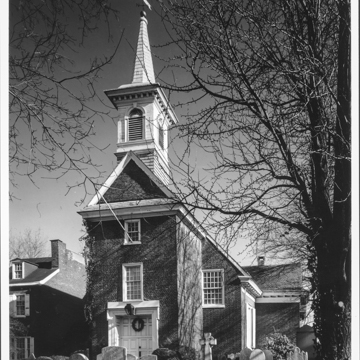William Penn attended the laying of the cornerstone and this is probably the only surviving building in his city in which he actually set foot. Gloria Dei, or “House to the Glory of God,” was built as the Swedish national church, but by a team of church builders led by English Quaker mason Joseph Yard and carpenter John Smart. Problems with Smart led to his replacement by the capable carpenter John I. Harrison, who later was involved in the first building for Christ Church (PH4). Their English training is reflected in the details of the building, but the plan with its original north pulpit reflected a northern European practice that also appears in many of the region's early Presbyterian churches. The scissors truss of the roof framing that permitted the plaster ceiling's cove led to a near failure of the walls, which was averted only by the construction of the transeptlike side vestibules added in 1703–1705 to serve as buttresses. The same team built the similar Swedish Holy Trinity Church in Wilmington, Delaware, a few years earlier and had similar difficulties—and remedies. The brick construction marks the arrival of Dutch brickmaking technology in the region; historian Beatrice Garvan has established that the bricks for the church were burned near Salem, New Jersey, and brought by boat to the site. Of particular note are the lozenges of glazed brick headers that distinguish the entrance facade and are suggestive of the types of patterned brickwork that ornament the gable ends of early houses in the Delaware Bay region.
The tower is a 1770s addition and the spire was added before 1800 when the church was depicted by William Birch in Views of Philadelphia (1800). The interior is unusual for its plaster vault that would have given the church reasonable acoustics. Balconies were added in the 1840s and the original pews were reduced in height. Much of the interior detail is from the alteration to its present three-aisle plan from its original two-aisle scheme by George C. Mason Jr. in 1896. The church remained in control of the Swedish National Church until 1845 when it was turned over to the Protestant Episcopal Church.











